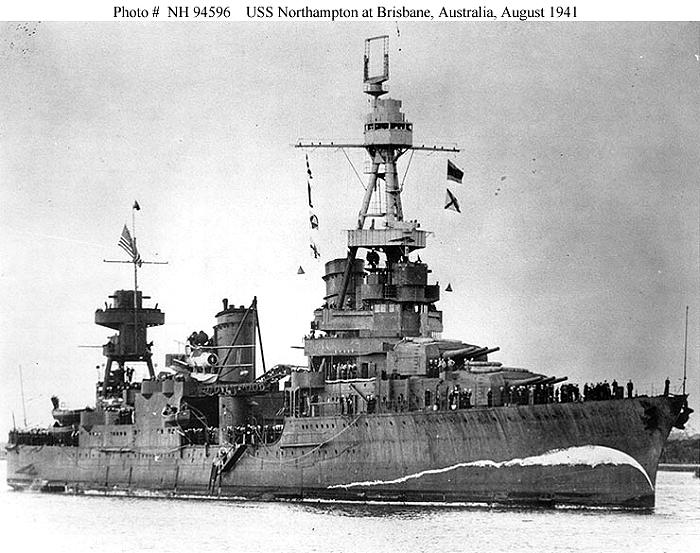

|
|
September 1942
USS Northampton (CA-26) first found in USS Helena CL-50 War Diary on 10 September 1942
USS Northampton (CA-26) Awards
USS Northampton (CL/CA-26) was the lead Northampton-class
Northampton was laid down on 12 April 1928, by Bethlehem Steel
Joining the Atlantic Fleet, Northampton made a shakedown cruise
World War II
Northampton was at sea with Admiral William Halsey, Jr. in
Through January 1942, Northampton joined in such searches until
On 4 March, the force launched aircraft for a strike on Marcus Island,
In mid-August, Northampton sailed for the Southwest Pacific to join in
During the battle of the Santa Cruz Islands on 26 October, which took
Loss at the Battle of Tassafaronga
Northampton next operated with a cruiser-destroyer force, to prevent
Close to the end of the engagement, Northampton was struck by two
The senior officer killed on Northampton during the battle of

USS Northampton (CA 26) entering the river at Brisbane, Australia, 5 August 1941.

cruiser in service with the United States Navy. She was
commissioned in 1930, originally classified a light cruiser
because of her thin armor but later reclassified a heavy cruiser
because of her 8-inch guns. During World War II she served in
the Pacific and was sunk by Japanese torpedoes during the Battle
of Tassafaronga on 30 November 1942. She was named after the
city of Northampton, Massachusetts, the home of former
President Calvin Coolidge.
Corp.'s Fore River Shipyard, Quincy, Massachusetts; launched on
5 September 1929; sponsored by Grace Coolidge (wife of the former
President); and commissioned on 17 May 1930, Captain (later Vice
Admiral) alter N. Vernou in command.
to the Mediterranean during the summer of 1930, then participated
in the fleet training schedule which took her to the Caribbean, the
Panama Canal Zone, and, occasionally, into the Pacific for exercises
with other cruisers and ships of all types. Redesignated CA-26 in
1931in accordance with the London Naval Treaty, she operated
primarily in the Pacific from 1932, homeported at San Pedro, and later
at Pearl Harbor. Northampton was one of six ships to receive the
new RCA CXAM radar in 1940.
Enterprise during the Japanese attack on Pearl Harbor on 7
December 1941, returning to port the next day. On 9 December, the
force sortied to search northeast of Oahu, then swept south to
Johnston Island, then north again to hunt the enemy west of Lisianski
Island and Midway Atoll. On 11 December, Craven was damaged
when it collided with Northampton during underway refueling.
detached with Salt Lake City to bombard Wotje on 1 February. The
bombardment not only demolished buildings and fuel dumps on the
island, but also sank two Japanese ships. A similar assault was fired
against Wake Island on 24 February when, despite serious enemy
counterfire, the guns of Northampton and her force started large fires
on the island and sank a dredge in the lagoon. As Northampton
retired from the island, enemy seaplanes, landbased planes, and
patrol craft attacked, but all were destroyed or repulsed.
then turned east for Pearl Harbor. Early in April, Enterprise's task force,
including Northampton, sortied once again, and joined Hornet
force for the Doolittle Raid on Tokyo 18 April. Once again the ships
replenished at Pearl Harbor, then sailed for the Southwest Pacific,
arriving just after the battle of the Coral Sea. Returning to Pearl Harbor,
Northampton prepared for the action soon to come at the battle of
Midway, when she screened Enterprise. On 4-5 June, the American
carriers launched their planes to win a great victory, turning the
Japanese back in mid-Pacific, and dealing them a tremendous blow by
sinking four carriers. Throughout the Battle of Midway,
Northampton protected her carrier and with her returned undamaged
to Pearl Harbor on 13 June.
the Guadalcanal operation. She patrolled southeast of San Cristobal,
where on 15 September her force was attacked by submarines, which
damaged Wasp and North Carolina, and struck O'Brien
only 800 yd (730 m) off Northampton's port beam. Now sailing with
Hornet, Northampton screened the carrier during attacks on
Bougainville Island on 5 October.
place without surface contact with the enemy, Northampton went to the
aid of Hornet, mortally wounded by enemy aircraft, and provided
antiaircraft cover while attempting to take the stricken carrier in tow.
Obviously doomed, the carrier was later sunk by destroyer torpedo
and gunfire, and the American force retired to the southwest.
the Japanese from reinforcing their troops on Guadalcanal. The Battle
of Tassafaronga began 40 minutes before midnight on 30 November,
when three American destroyers made a surprise torpedo attack on
the Japanese. All American ships then opened fire, which the startled
enemy did not return for seven minutes. Two of the American cruisers
took torpedo hits within the space of a minute, and 10 minutes later,
another was hit, all being forced to retire from the action. Northampton
and Honolulu, with six destroyers, continued the fierce action.
torpedoes, which tore a huge hole in her port side, ripping away
decks and bulkheads. Flaming oil sprayed over the ship; she took on
water rapidly and began to list. Three hours later, as she began to sink
stern-first, she had to be abandoned. So orderly and controlled was
the process that loss of life was surprisingly light, and the survivors
were all picked up within an hour by destroyers.[5] While it was a
tactical defeat, as three cruisers had been severely damaged and
Northampton lost[5] in exchange for the loss of only one Japanese
destroyer, nevertheless the Japanese had been denied a major
reinforcement.
Tassafaronga was Chief Engineer, Commander (select) Hilan Ebert of
Alliance, Ohio. Ebert was awarded the Navy Cross. In honor of
Commander Ebert, the Ebert was launched 11 May 1944 by Tampa
Shipbuilding Co., Inc., Tampa, Florida; sponsored the widow of
Commander Ebert; Mrs. Hilan Ebert